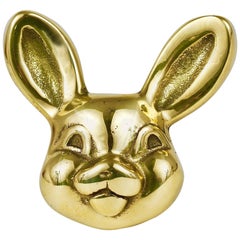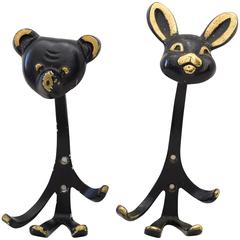Walter Bosse Rabbit
Mid-20th Century Austrian Mid-Century Modern Barware
Brass
Recent Sales
Vintage 1950s Austrian Mid-Century Modern Wardrobes and Armoires
Brass
Vintage 1950s Austrian Mid-Century Modern Wall Brackets
Brass
Mid-20th Century Austrian Mid-Century Modern Coat Racks and Stands
Brass
Mid-20th Century Austrian Mid-Century Modern Wardrobes and Armoires
Brass
Vintage 1950s Austrian Mid-Century Modern Wardrobes and Armoires
Brass
Mid-20th Century Austrian Mid-Century Modern Animal Sculptures
Brass
Vintage 1950s Austrian Mid-Century Modern Animal Sculptures
Brass
Vintage 1950s Austrian Mid-Century Modern Animal Sculptures
Brass
Vintage 1930s Austrian Art Deco Animal Sculptures
Ceramic
Mid-20th Century Austrian Mid-Century Modern Wardrobes and Armoires
Brass
Mid-20th Century Austrian Mid-Century Modern Wardrobes and Armoires
Brass
Mid-20th Century Austrian Mid-Century Modern Wall Brackets
Brass
Walter Bosse for sale on 1stDibs
Credited with thousands of works and models for ceramic pieces, Walter Bosse was an intensely prolific designer. The modernist Austrian sculptor and ceramist was best known for his distinctive “Black Golden” series of decorative objects and figurines, particularly his hedgehog ashtrays. Bosse’s mid-century and Art Deco works were popular as gifts for politicians and royalty worldwide, remaining coveted among collectors today.
Bosse was born in Vienna in 1904 to artist parents — his father, Julius, was a portrait painter for the Austrian Imperial Court. Bosse studied at the University of Applied Arts in Vienna from 1918 to 1921 under Austrian sculptor Michael Powolny and Austrian painter Franz Cizek. Later, he continued at the Munich School of Applied Arts in Germany under Austrian architect and designer Josef Hoffmann, a founder of the Vienna Secession movement.
Early in his career, Bosse worked as a designer at several ceramics manufacturers, including Augarten Porcelain Works in 1924, Goldscheider Porcelain Manufactory and Majolica Factory in 1926 and Metzler and Ortloff in 1927. In 1925, Bosse displayed several pieces at the International Exposition of Modern Industrial and Decorative Arts in Paris, which introduced the Art Deco style to a global audience.
In 1931, Bosse opened a shop in Kufstein, Austria, selling ceramic gift items. Owing to the crippling economic effects of the Great Depression, however, Bosse was forced to close his shop in 1937. He returned to Vienna in 1938 and opened another business, Bosse Keramik, where he sold toys, glass, textiles and more. In the late 1940s, Bosse experimented with small-scale brass sculptures and desk accessories coated in black ceramic glaze. With Austrian designer Herta Baller, Bosse formed the Bosse-Baller company to manufacture the “Black Golden” line of figurines, which became wildly popular worldwide.
Despite Bosse’s success, he struggled financially and moved to Iserlohn, Germany, in 1953. Meanwhile, Baller continued to manufacture and sell Bosse’s designs, which were so popular that forgers copied and sold counterfeit editions of Bosse’s works around the world. The 1950s marked the debut of the artist’s whimsically zoomorphic hedgehog ashtrays — these were cast in brass, and a hedgehog ashtray in any other material is not a Bosse original.
Bosse spent the rest of his life embroiled in court battles to protect his designs, leaving him penniless by the time he died. Today authentic Bosse pieces — from wall-mounted sculptures to tableware — continue to be highly sought after by collectors.
Find vintage Walter Bosse serveware, wall decorations and more on 1stDibs.
A Close Look at mid-century-modern Furniture
Organically shaped, clean-lined and elegantly simple are three terms that well describe vintage mid-century modern furniture. The style, which emerged primarily in the years following World War II, is characterized by pieces that were conceived and made in an energetic, optimistic spirit by creators who believed that good design was an essential part of good living.
ORIGINS OF MID-CENTURY MODERN FURNITURE DESIGN
- Emerged during the mid-20th century
- Informed by European modernism, Bauhaus, International style, Scandinavian modernism and Frank Lloyd Wright’s architecture
- A heyday of innovation in postwar America
- Experimentation with new ideas, new materials and new forms flourished in Scandinavia, Italy, the former Czechoslovakia and elsewhere in Europe
CHARACTERISTICS OF MID-CENTURY MODERN FURNITURE DESIGN
- Simplicity, organic forms, clean lines
- A blend of neutral and bold Pop art colors
- Use of natural and man-made materials — alluring woods such as teak, rosewood and oak; steel, fiberglass and molded plywood
- Light-filled spaces with colorful upholstery
- Glass walls and an emphasis on the outdoors
- Promotion of functionality
MID-CENTURY MODERN FURNITURE DESIGNERS TO KNOW
- Charles and Ray Eames
- Eero Saarinen
- Milo Baughman
- Florence Knoll
- Harry Bertoia
- Isamu Noguchi
- George Nelson
- Danish modernists Hans Wegner and Arne Jacobsen, whose emphasis on natural materials and craftsmanship influenced American designers and vice versa
ICONIC MID-CENTURY MODERN FURNITURE DESIGNS
- Eames lounge chair
- Nelson daybed
- Florence Knoll sofa
- Egg chair
- Womb chair
- Noguchi coffee table
- Barcelona chair
VINTAGE MID-CENTURY MODERN FURNITURE ON 1STDIBS
The mid-century modern era saw leagues of postwar American architects and designers animated by new ideas and new technology. The lean, functionalist International-style architecture of Le Corbusier and Bauhaus eminences Ludwig Mies van der Rohe and Walter Gropius had been promoted in the United States during the 1930s by Philip Johnson and others. New building techniques, such as “post-and-beam” construction, allowed the International-style schemes to be realized on a small scale in open-plan houses with long walls of glass.
Materials developed for wartime use became available for domestic goods and were incorporated into mid-century modern furniture designs. Charles and Ray Eames and Eero Saarinen, who had experimented extensively with molded plywood, eagerly embraced fiberglass for pieces such as the La Chaise and the Womb chair, respectively.
Architect, writer and designer George Nelson created with his team shades for the Bubble lamp using a new translucent polymer skin and, as design director at Herman Miller, recruited the Eameses, Alexander Girard and others for projects at the legendary Michigan furniture manufacturer.
Harry Bertoia and Isamu Noguchi devised chairs and tables built of wire mesh and wire struts. Materials were repurposed too: The Danish-born designer Jens Risom created a line of chairs using surplus parachute straps for webbed seats and backrests.
The Risom lounge chair was among the first pieces of furniture commissioned and produced by legendary manufacturer Knoll, a chief influencer in the rise of modern design in the United States, thanks to the work of Florence Knoll, the pioneering architect and designer who made the firm a leader in its field. The seating that Knoll created for office spaces — as well as pieces designed by Florence initially for commercial clients — soon became desirable for the home.
As the demand for casual, uncluttered furnishings grew, more mid-century furniture designers caught the spirit.
Classically oriented creators such as Edward Wormley, house designer for Dunbar Inc., offered such pieces as the sinuous Listen to Me chaise; the British expatriate T.H. Robsjohn-Gibbings switched gears, creating items such as the tiered, biomorphic Mesa table. There were Young Turks such as Paul McCobb, who designed holistic groups of sleek, blond wood furniture, and Milo Baughman, who espoused a West Coast aesthetic in minimalist teak dining tables and lushly upholstered chairs and sofas with angular steel frames.
As the collection of vintage mid-century modern chairs, dressers, coffee tables and other furniture for the living room, dining room, bedroom and elsewhere on 1stDibs demonstrates, this period saw one of the most delightful and dramatic flowerings of creativity in design history.
Materials: brass Furniture
Whether burnished or lacquered, antique, new and vintage brass furniture can elevate a room.
From traditional spaces that use brass as an accent — by way of brass dining chairs or brass pendant lights — to contemporary rooms that embrace bold brass decor, there are many ways to incorporate the golden-hued metal.
“I find mixed metals to be a very updated approach, as opposed to the old days, when it was all shiny brass of dulled-out silver tones,” says interior designer Drew McGukin. “I especially love working with brass and blackened steel for added warmth and tonality. To me, aged brass is complementary across many design styles and can trend contemporary or traditional when pushed either way.”
He proves his point in a San Francisco entryway, where a Lindsey Adelman light fixture hangs above a limited-edition table and stools by Kelly Wearstler — also an enthusiast of juxtapositions — all providing bronze accents. The walls were hand-painted by artist Caroline Lizarraga and the ombré stair runner is by DMc.
West Coast designer Catherine Kwong chose a sleek brass and lacquered-parchment credenza by Scala Luxury to fit this San Francisco apartment. “The design of this sideboard is reminiscent of work by French modernist Jean Prouvé. The brass font imbues the space with warmth and the round ‘portholes’ provide an arresting geometric element.”
Find antique, new and vintage brass tables, case pieces and other furnishings now on 1stDibs.


